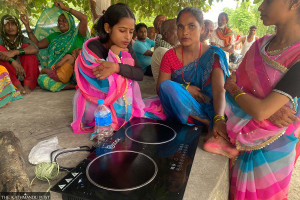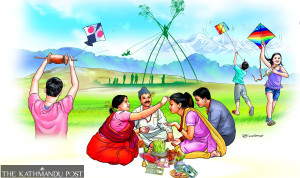Money
Value of Nepal's exports swells due to stronger dollar
Shipments were worth Rs35.36 billion in the last fiscal year 2020-21, up from Rs27.63 billion in 2019-20.
Krishana Prasain
The value of Nepal's exports in the last fiscal year registered a sharp 27.97 percent year-on-year jump, which traders say was mainly the result of a stronger dollar and higher prices fuelled by a production shortfall in neighbouring India.
Shipments of listed or high-value products reached Rs35.36 billion in the last fiscal year 2020-21 ended mid-July, up from Rs27.63 billion in 2019-20, according to the annual statistics of the Trade and Export Promotion Centre.
Exports of products listed in the Nepal Trade Integration Strategy like large cardamom, pashmina, tea, ginger, textile, yarn, carpet, medicinal herbs and footwear swelled during the last fiscal year.
The share of these listed products in Nepal’s total exports in the last fiscal year stood at 25 percent. Nepal exported goods worth Rs141 billion in the last fiscal year while imports amounted to Rs1.53 trillion, resulting in a staggering trade deficit of Rs1.39 trillion.
Sharad Bikram Rana, former executive director of the centre, said the export quantity of listed products increased slightly. “The key reason for listed products performing well this year amid the Covid-19 pandemic is the appreciation of the US dollar against the Nepali rupee.”
Large cardamom shipments, Nepal's niche product with increasing popularity among premium class consumers in the global market, shot up by 74.7 percent to Rs7 billion in the last fiscal year. Exports totalled Rs4 billion in the previous fiscal year.
Nirmal Bhattarai, immediate past president of the Large Cardamom Entrepreneurs Association of Nepal, said that output of large cardamom, one of the world's most expensive spices, rose by around 30 percent.
“The price is expected to increase further as production of large cardamom in India has declined,” he said.
Large cardamom was sold at Rs550-600 per kg last year. Due to increased demand triggered by a production shortfall, the price reached Rs900 per kg in the last fiscal year, Bhattarai said.
Nepal is the world's largest producer of large cardamom with a 68 percent share of the global market, followed by India (22 percent) and Bhutan (9 percent).
Despite the difficulties caused by Covid-19 in the transport sector, pashmina shipments soared by 44.3 percent to Rs2.54 billion in the last fiscal year. Pashmina exports were valued at Rs1.76 billion in the previous fiscal year.
Dhana Prasad Lamichhane, secretary of the Nepal Pashmina Industries Association, said that the cost of production of making pashmina had increased due to a hike in raw material prices imported from China. “The price hike in finished goods resulted in a higher export value.”
He said that global demand for pashmina had declined, and factories were not able to run at full capacity due to the coronavirus.
Pashmina was exported to Germany, the United States, the United Kingdom, France, India, Switzerland and the Netherlands.
Tea exports saw a whopping 36.5 percent rise to Rs3.79 billion in the last fiscal year from Rs2.78 billion in the previous fiscal.
Suresh Kumar Agrawal, president of the Nepal Tea Planters Association, said that the price of CTC (crush, tear, curl) tea which is mainly grown in the Tarai region, fell to around Rs200 per kg from a high of Rs350 in the last fiscal year.
But orthodox tea received good value in the global market, he said.
Nepali tea reaped a bonanza following a drop in output in the key growing countries—India and Sri Lanka—and increased demand in the global market.
Nepal exports most of its tea to India, Germany, Russia, Japan and the Czech Republic.
Textile shipments saw a rise of 14.5 percent to Rs3.29 billion in the last fiscal year from Rs2.87 billion in the previous fiscal year.
Shipment of yarns increased by 17.6 percent to Rs8.52 billion in the last fiscal year, from Rs7.25 billion in the previous fiscal year. Yarns were mostly exported to India and Turkey.
Carpet shipments grew by 17.6 percent to Rs7.24 billion in the last fiscal from Rs6.15 billion in the previous fiscal year. Most of Nepal's carpet exports went to the US, Germany, the UK, Italy, France, China, Belgium, Australia, Canada and Switzerland.
Shipments of medicinal herbs increased by 8.3 percent to Rs1.69 billion from Rs1.56 billion. Ginger exports rose by 2.9 percent to Rs448 million. The export of footwear was Rs795 million in the last fiscal year, from Rs786 million in the previous fiscal year.
According to Rana, it will take time for Nepal's exports to bounce back as the world is still fighting emerging coronavirus variants and prioritising vaccination drives against Covid.
The export of Nepal’s high-value goods is still nominal, and a favourable policy matching the changing global trade context is required, he said.
“It has been three years since the government decided to introduce an ‘export house’ policy targeting micro, small and medium entrepreneurs to promote local products. But nothing has moved ahead,” Rana said.
The centre submitted guidelines for the formulation of policy three years ago to the Ministry of Industry, Commerce and Supplies for final approval.
Under this policy, the centre will build the capacity of micro, small and medium entrepreneurs, and offer a 5 percent cash incentive to encourage the production of exportable goods, Rana said.
“Policy gaps, bureaucratic hindrances, ineffective policy and lack of coordination between government agencies in the implementation of policy and programmes are the major reasons behind the failure to achieve export targets for listed products,” he said.
The government mentions export houses in every budget statement, but the plan has never been implemented, he added.




 20.26°C Kathmandu
20.26°C Kathmandu













